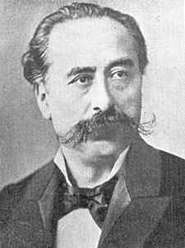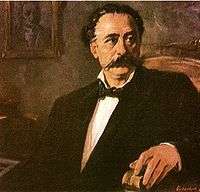Tigran Tchoukhajian
| Dikran Tchoukhadjian (western Armenian) Tigran Tchoukhajian (eastern Armenian) | |
|---|---|
 | |
| Born |
1837 Constantinople, Ottoman Empire |
| Died |
March 11, 1898 Smyrna, Ottoman Empire |
| Other names | Dikran Chouhajian |
| Occupation | Composer, conductor, public activist |
| Known for | Founder of the first opera institution in the Ottoman Empire |
Tigran Tchoukhajian (Armenian: Տիգրան Չուխաճեան,[1] Turkish: Dikran Çuhacıyan; 1837 – March 11, 1898)[2] was an Ottoman Armenian composer, conductor, public activist and the founder of the first opera institution in the Ottoman Empire.[3] He is considered the first opera composer in Turkish history.[4]
Biography
Tchoukhajian was born in Constantinople. He studied at composer Gabriel Yeranian's class, then had classes in Milan. Along with other Armenian intellectuals of that period he fought for the development of national culture, organized Armenian musical societies, theatres, schools, papers and free concerts. In his works, Tchoukhajian used the elements of European musical techniques and Armenian folk melodies.[5] He is an author of pieces for piano, songs and romances, chamber and symphonic works, operas (Zemire, 1890; Leblebiji, 1875) etc. In 1862, he took over publication of the Armenian musical journal Armenian Lyre. He died in Smyrna (now İzmir). Tchouhadjian is buried in the Armenian cemetery of Smyrna.
He created the first Armenian opera, Arshak II (1868, partially staged in 1873), based on the historical figure King Arsaces II (Arshak II). It is the first “Armenian grand opera” with choruses and ballets, and was assembled on November 29, 1945 at the Armenian Opera Theater opera theater in Yerevan. Arshak II is a "gem" of Armenian musical culture and it has continued to grace the repertoire of the Yerevan Opera Theater. In 2001, it was staged at the San Francisco Opera.
Tchoukhajian is also remembered as the composer of what may have been the first original opera in Turkish, Arif'in Hilesi (Arif's Deception),[6][7] though Donizetti's Belisario had been staged in Turkish translation in 1840.[8]

.jpg) |
 |
(c. 1875) |
(c. 1890) |
Selected compositions
Operas
- Arshak II (1868)
- Leblebidji Hor-Hor Agha (1875)
- Zémir (1891)
- Indiana (1897)
References
- ↑ The Classical spelling of his name in Armenian. In the reformed orthography it is spelled Տիգրան Չուխաջյան
- ↑ Razmik Panossian, (2013) The Armenians: From Kings and Priests to Merchants and Commissars. Columbia University Press. ISBN 0231511337. p. 334
- ↑ Donald Jay Grout; Hermine Weigel Williams (2003). A Short History of Opera. Columbia University Press. p. 529. ISBN 978-0-231-11958-0.
- ↑ Cowden, Robert H., ed. (1992). Opera companies of the world : selected profiles. New York: Greenwood Press. ISBN 0313262209.
- ↑ Чухаджян Тигран Геворгович. Great Soviet Encyclopedia
- ↑ Türk tiyatro tarihi – Page 66 Metin And – 1992 "Dikran Çuhacıyan, imzasıyla halka seslenirken ve amacını açıklarken, Güllü Agop da Arifin Hilesi'nin vodvil olduğunu, bu bakımdan tekelin kapsamına girdiğini ileri sürüyordu. Öteki gazeteler de tartışmaya katıldılar. Bu arada Güllü Agop'un ..."
- ↑ The Athenæum 1874 Page 616 "Tun Festival of the Ramazan, in Constantinople, has been marked by the production of an opera in Turkish and the foundation of an Opera house for the Moslem quarter of Stamboul. The name of the piece is ' Arifiu-heilessi'; the composer is ... The name of the piece is 'Arifiu-heilessi'; the composer is Mr. Digran Chohajian (= Tailor-son), an Armenian ; and the authors of the libretto are Haled Bey, Mahir Bey, and other Turkish gentlemen. The piece was received with enthusiasm by ..."
- ↑ Newsletter of the Research Centre for Islamic History, Art, and Culture – Page 41 1999 "... operettas were put on stage in the Naum Theatre in the Pera district of Istanbul. At the beginning, the plays were in French and the roles were undertaken by Armenian. Jewish and Greek artists. The first opera in Turkish was staged in 1840."
Bibliography
- Nikoghos Tahmizian, Tigran Tchoukhajian – Life and Work, trans. Aris Sevag, Pasadena, CA: Drazark Publishing, 2001. (translated from "Dikran Tchouhadjian: gyanku yev steghtazakortzoutiunu," 1999)
External links
| Wikimedia Commons has media related to Dikran Tchouhadjian. |
- Chukhajian – Arsaces II – Aram Katanyan
- In the Footsteps of Tchouhadjian — documentary film about Dikran Tchouhadjian